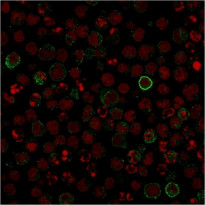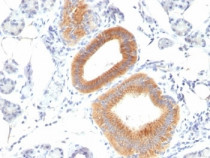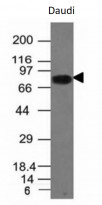ARG58026
anti-CD86 antibody [C86/1146]
anti-CD86 antibody [C86/1146] for ICC/IF,IHC-Formalin-fixed paraffin-embedded sections,Western blot and Human
Overview
| Product Description | Mouse Monoclonal antibody [C86/1146] recognizes CD86 |
|---|---|
| Tested Reactivity | Hu |
| Predict Reactivity | Ms, Rat |
| Tested Application | ICC/IF, IHC-P, WB |
| Host | Mouse |
| Clonality | Monoclonal |
| Clone | C86/1146 |
| Isotype | IgG1, kappa |
| Target Name | CD86 |
| Antigen Species | Human |
| Immunogen | Recombinant full-length protein of Human CD86. |
| Conjugation | Un-conjugated |
| Alternate Names | B70; B7.2; LAB72; CD antigen CD86; B7-2; FUN-1; CD28LG2; T-lymphocyte activation antigen CD86; CTLA-4 counter-receptor B7.2; Activation B7-2 antigen; BU63 |
Application Instructions
| Application Suggestion |
|
||||||||
|---|---|---|---|---|---|---|---|---|---|
| Application Note | IHC-P: Antigen Retrieval: Boil tissue section in 10 mM Tris buffer with 1 mM EDTA (pH 9.0) for 10-20 min, followed by cooling at RT for 20 min. * The dilutions indicate recommended starting dilutions and the optimal dilutions or concentrations should be determined by the scientist. |
Properties
| Form | Liquid |
|---|---|
| Purification | Purification with Protein G. |
| Buffer | PBS, 0.05% Sodium azide and 0.1 mg/ml BSA. |
| Preservative | 0.05% Sodium azide |
| Stabilizer | 0.1 mg/ml BSA |
| Concentration | 0.2 mg/ml |
| Storage Instruction | For continuous use, store undiluted antibody at 2-8°C for up to a week. For long-term storage, aliquot and store at -20°C or below. Storage in frost free freezers is not recommended. Avoid repeated freeze/thaw cycles. Suggest spin the vial prior to opening. The antibody solution should be gently mixed before use. |
| Note | For laboratory research only, not for drug, diagnostic or other use. |
Bioinformation
| Database Links |
Swiss-port # P42081 Human T-lymphocyte activation antigen CD86 |
|---|---|
| Gene Symbol | CD86 |
| Gene Full Name | CD86 molecule |
| Background | This gene encodes a type I membrane protein that is a member of the immunoglobulin superfamily. This protein is expressed by antigen-presenting cells, and it is the ligand for two proteins at the cell surface of T cells, CD28 antigen and cytotoxic T-lymphocyte-associated protein 4. Binding of this protein with CD28 antigen is a costimulatory signal for activation of the T-cell. Binding of this protein with cytotoxic T-lymphocyte-associated protein 4 negatively regulates T-cell activation and diminishes the immune response. Alternative splicing results in several transcript variants encoding different isoforms.[provided by RefSeq, May 2011] |
| Function | Receptor involved in the costimulatory signal essential for T-lymphocyte proliferation and interleukin-2 production, by binding CD28 or CTLA-4. May play a critical role in the early events of T-cell activation and costimulation of naive T-cells, such as deciding between immunity and anergy that is made by T-cells within 24 hours after activation. Isoform 2 interferes with the formation of CD86 clusters, and thus acts as a negative regulator of T-cell activation. [UniProt] |
| Calculated MW | 38 kDa |
| PTM | Polyubiquitinated; which is promoted by MARCH8 and results in endocytosis and lysosomal degradation. [UniProt] |
Images (3) Click the Picture to Zoom In
-
ARG58026 anti-CD86 antibody [C86/1146] ICC/IF image
Immunofluorescence: Raji cells stained with ARG58026 anti-CD86 antibody [C86/1146] (green). Reddot (red) for nuclear staining.
-
ARG58026 anti-CD86 antibody [C86/1146] IHC-P image
Immunohistochemistry: Formalin-fixed and paraffin-embedded Human melanoma stained with ARG58026 anti-CD86 antibody [C86/1146].
-
ARG58026 anti-CD86 antibody [C86/1146] WB image
Western blot: Daudi cell lysate stained with ARG58026 anti-CD86 antibody [C86/1146].








